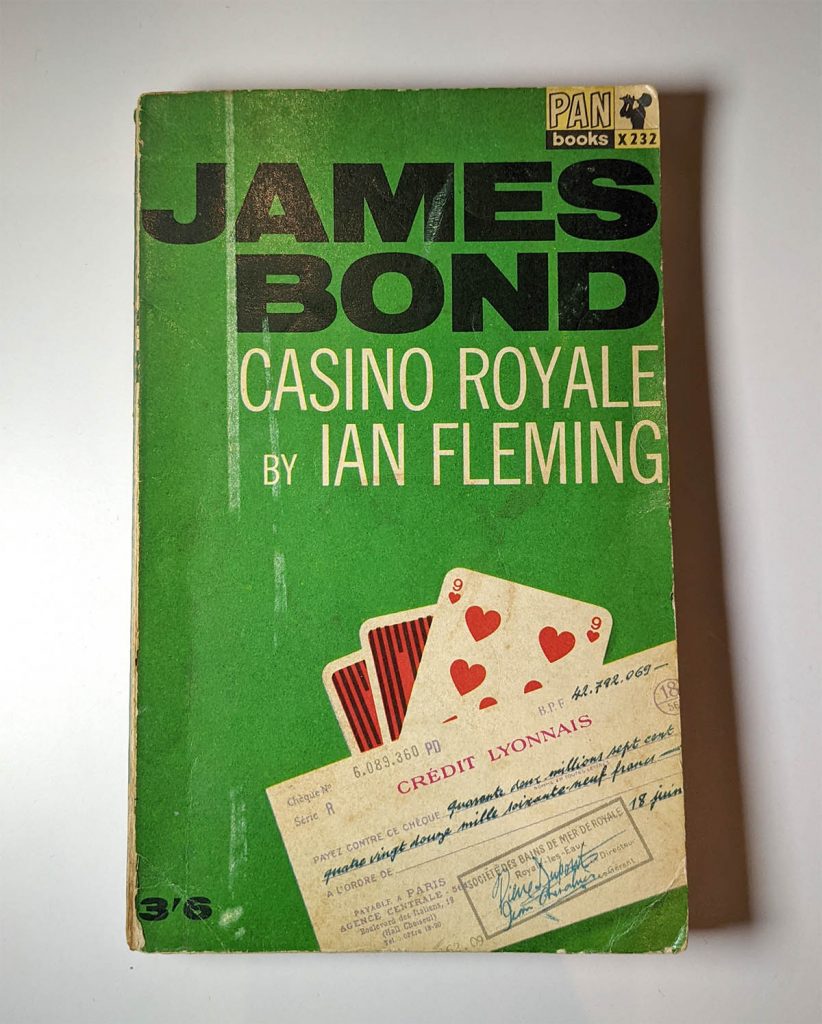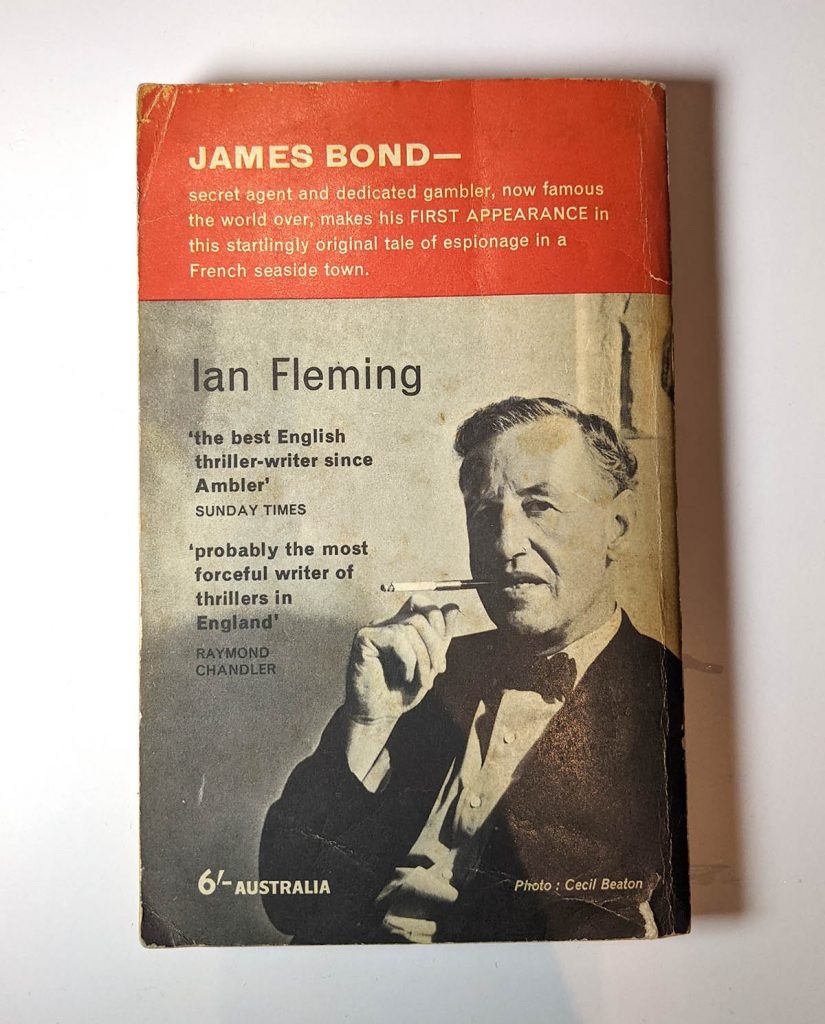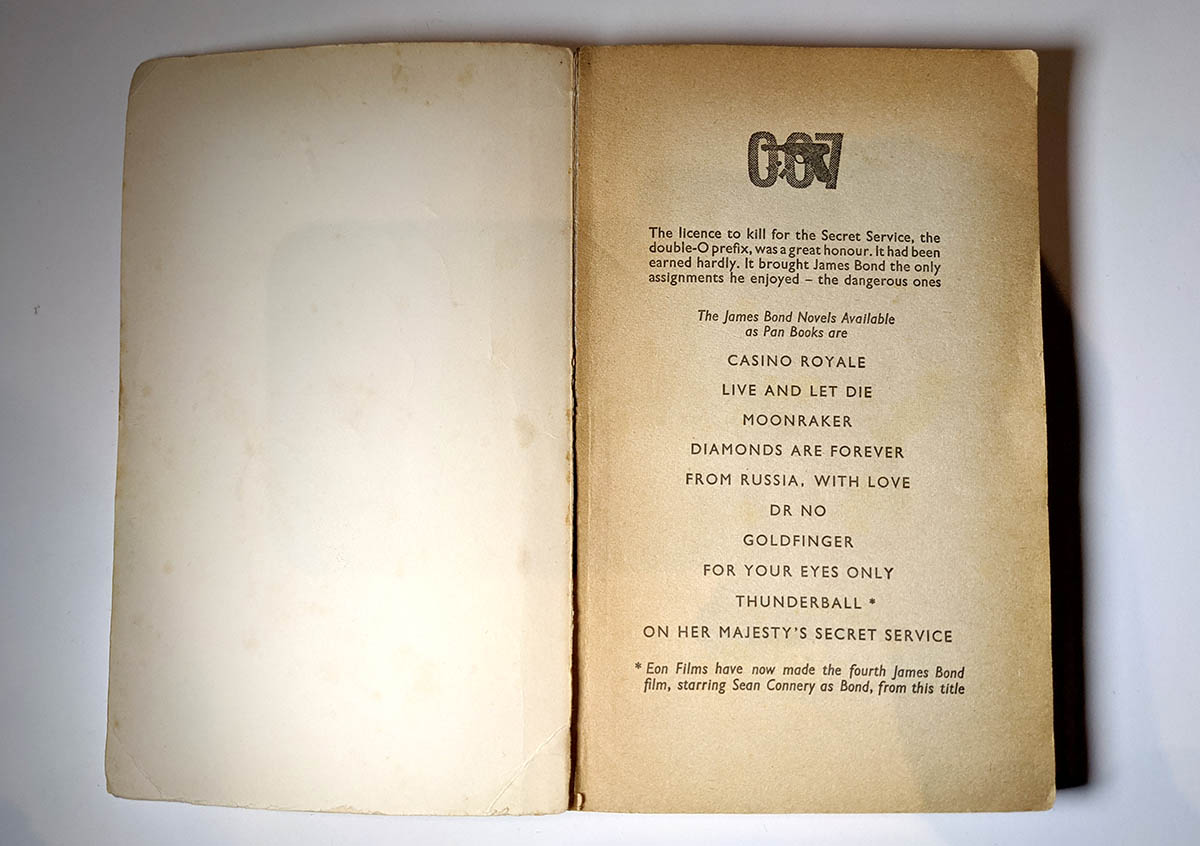And so it begins. At the start of the year, I gave myself a James Bond challenge. I wanted to rewatch all the Bond movies in order, and rank them. But I then added in reading all the original Ian Fleming novels for the first time too. It will take time but I’m going to thoroughly enjoy the process.
Although Dr No. was the first Eon productions movie and the first ‘proper Bond movie’ in most people’s eyes, there had been an on screen appearance of the James Bond character earlier, in a 1954 TV episode of Climax! entitled ‘Casino Royale’. This episode was aired only a year after Casino Royale, the first Bond novel, had been published, which goes to show how much of an immediate success Fleming had with the books. The second novel, ‘Live and Let Die’ actually came out about a month before the TV episode aired, which just shows how quickly everything happened in those first two years. CBS paid Fleming $1,000 for the rights to bring Casino Royale to the screen in the Climax! episode. These rights to Casino Royale eventually moved on to Gregory Ratoff and then Charles K. Feldman. Meanwhile, while Fleming’s books grew in popularity he negotiated a better deal for the rights to all his other books with Albert R. (Cubby) Broccoli and Harry Saltzman who founded Eon productions and ultimately got backing from United Artists to make the main Bond film series. Casino Royale would be the one that got away from Eon productions, and after the success of four Sean Connery films, Charles K. Feldman cashed in on his Casino Royale rights and made the spoof Bond film starring David Niven. It wasn’t until 1999 that Eon Productions managed to get hold of the Casino Royale rights and finally own the rights to all the original Fleming novels. This obviously led to the 2006 Daniel Craig movie.
So basically Casino Royale has a pretty interesting history. I’m not going to review the Daniel Craig movie yet of course, as it’s a very modern retelling of Bond and I’m watching the movies in release order, but I still wanted to address the rest of the Casino Royale instances in one go, even though the 1967 movie was well into the main James Bond run. Besides, although I’m not fussed about reading the books in order I did want to start my James Bond challenge with the very first appearance of Bond, which of course is in the Casino Royale novel. So for this first post, I will be looking at the Casino Royale novel, and then in the next two posts I will look at the TV episode and the 1967 movie of Casino Royale. Remember you can read my previous post to see the James Bond timeline I created.



Casino Royale novel by Ian Fleming – 1953
A friend of mine at school, when I was about 12, told me that he had read all the James Bond novels and that he loved them, and I think I started reading Diamonds are Forever at that time, but I never got hooked on them. I always vowed that I would go back and read them one day though. I didn’t think it would take me another 32 years though.
To be honest I didn’t really know what to expect. I certainly assumed they would be pretty exciting and I know Fleming had a very interesting past himself being a Naval Intelligence Officer during the Second World War. But I didn’t know how good technically he was a writer. A part of me assumed he might not be that great but that he would just be able to write about exciting content. Little did I know that he’s actually very highly regarded as a writer. His books seem to have received wide critical acclaim and The Times ranked him as Britain’s 14th best author in a list of the 50 greatest British authors since 1945.
Here is my bullet point brain dump whilst reading the book:
- WARNING – There will be some minor spoilers in this book. But not huge ones. For example I won’t be revealing the last line of the book.
- FYI I’m reading a printing of the book from 1965. The 23rd reprinting. I wonder how many reprints it’s had now! It was first released in 1953.
- I love the quote on the inside cover. “The licence to kill for the Secret Service, the double-O-prefix, was a great honour. It had been earned hardly. It brought James Bond the only assignments he enjoyed – the dangerous ones.”
- And the first line is fantastic. An immediate insight into the world of James Bond. “The scent and smoke and sweat of a casino are nauseating at three in the morning.”
- It says Bond lit his seventieth cigarette of the day?! Wow.
- I always thought SMERSH was a spoof organisation just used in the David Niven movie, because all the other movies have SPECTRE as the enemy. But it was good to discover that SMERSH actually is a legit Soviet agency in the novels. Its name always sounded made up but it actually is derived from the Russian for ‘Death to spies’. SPECTRE is apparently later spawned from within SMERSH I believe, but it was good to read about the origins of SMERSH in this novel. I believe the name SMERSH basically stands for ‘death to spies’ in Russian.
- Great to read M and Moneypenny in the book. Q is also mentioned although I don’t think there’s any interaction with him that I can remember. In fact I like Fleming’s use of a flashback here. It kind of allows him to have a cold open at the start of the novel, which the movies of course are known for, and then still go back and set the scene of the start of Bond’s mission. To be totally honest though, I was expecting the opening of the book to be slightly more exciting. I found it slightly slow paced at the start. It does pick up later though.
- Great to see Felix Leiter also mentioned too. I was never quite sure the history between Bond and Leiter and how far their friendship went back in the movies. Nice to see that he appears in the very first book.
- Before embarking on reading these Fleming novels, I had been warned against the misogynistic writing and the views of the time. I knew to take some of the writing with a pinch of salt as it was the product of its time. There’s a perfect example on p33, after Vesper Lynd’s involvement led to a hiccup in Bond’s plan. “And then there was this pest of a girl. He sighed. Women were for recreation. On a job, they got in the way and fogged things up with sex and hurt feelings and all the emotional baggage they carried around. One had to look out for them and take care of them. ‘Bitch,’ said Bond, and then remembering the Muntzes, he said ‘bitch’ again more loudly and walked out of the room.” Even in the movies Bond often comes across a bit arrogant (sometimes more than a bit) but actually until this point in the novel I found Bond to come across actually fairly humble and self-doubting in a refreshing way. But his views about women certainly do come out here.
- And on p40 “He was quite honest to himself about the hypocrisy of his attitude towards her. As a woman, he wanted to sleep with her but only when the job had been done.”
- Bond takes lots of cold showers in this book. This made me laugh. I didn’t know whether it’s because he knows it’s good to energise his system and make him more alert, or whether it’s just because he’s so bloody horny.
- The word ‘ironical’ is used a heck of a lot in this book. I guess it was a commonly used word of the time.
- There’s a wonderful section from p47-50 where Fleming goes deep into Bond’s love of gambling, casinos and cards. It’s a subject I enjoy too, so was great to read Fleming wax lyrical about it. It’s very well written and it actually sets up his strategy for gambling in the game against Le Chiffre later in the book. Again though, there is a comparison to women. “Bond saw luck as a woman, to be softly wooed or brutally ravaged, never pandered to or pursued.” Brutally ravaged, huh? Interesting choice of words.
- I love the section on p51 where Bond orders his drink. He doesn’t order a Vodka Martini shaken not stirred. That must come later. Here he orders his own concoction for which he doesn’t yet have a name. “A dry martini. One. In a deep champagne goblet. Three measures of Gordon’s, one of vodka, half a measure of Kina Lillet. Shake it very well until it’s ice-cold, then add a large thin slice of lemon-peel. Got it?” He later calls this drink ‘The Vesper’ after Vesper Lynd, the character he works with in the book. I thought it would be great to try this cocktail in real life. I’ve got a friend of mine who is a bit of a mixologist and I asked him if he would be able to make it one day. He said he had heard of it and definitely would be up for trying to make it one day. Then about an hour later he knocks on my door, asks me to get a glass and proceeds to pour me a Vesper, socially distancing on my doorstep! Very nice indeed of him and I can say the drink is very nice indeed too!

- One thing that I noticed about this book, which I really liked, was that it had chapter titles. So many books these days just have numbers for the chapters, but these titles that Fleming wrote are also extremely cool. I could imagine some of them could be used for future Bond movie titles, as we’re running out of actual book and short story titles to use. Here are a few examples. ‘Rouge et Noir’, ‘Two Men in Straw Hats’, ‘The Deadly Tube’, ‘A Whisper of Love, A Whisper of Hate’, ‘The Crawling of the Skin’, ‘The Nature of Evil’, ‘Black-Patch’ , ‘Sleep Well, My Darling’, ‘The Bleeding Heart’. I also like how the chapters are nice and short. The book in general is very readable. Not too long overall and nice short chapters.
- On p50 we have the first instance of Bond introducing himself in his famous way, and it’s to Felix Leiter, which is nice. After Leiter gives Bond his name, Bond replies with “Mine’s Bond – James Bond”. It’s good to see that this wasn’t just something added to the movie scripts, and that it was present from the very first novel.
- It was very interesting to read that Bond went through a visualisation exercise during his preparation for the big evening of the mission. He sits in his room and goes through everything in his head, visualising all possible scenarios. In the movies you kind of get the impression that Bond is just always ready for everything and never really has to plan. But here it was good to see that Bond does go through preparation exercises and one of them was to go through possible scenarios and how he and other people might react. After this prep Fleming writes, “He rose and dressed, dismissing the future completely from his mind”. I love that too. He’s done the visualisation and what-if scenarios in his mind so that he is prepared, and with that knowledge that he has done a thorough preparation he is now able to remove any apprehension and be absolutely present in the moment. So many people today use visualisation tools and try to be in the present to enjoy life, so it’s great to see that Fleming was aware of this back in the early 50s.
- Bond tells Vesper that it’s not difficult to get a Double O number if you’re prepared to kill people. He goes on to list the people that he killed in order to get his Double-O. A cipher expert and a double agent. It’s a very interesting insight here into the more pragmatic and cold side of his job. Basically a couple of times in the book he almost refers to himself as just an assassin. In the movies you always kind of get the sense that the Licence to Kill is really just that if he has to kill somebody in self defence then he won’t be prosecuted for it. But in the book it really does highlight that some of his role is just to be a glorified hitman.
- Fleming goes on to explain the rules of Baccarat, and he does it in a very engaging way. If any teacher or YouTuber wants to teach Baccarat to anyone they could do a lot worse than to copy how Fleming describes it! I always thought it was a very complex game, but actually it’s very much like Blackjack or Pontoon.
- John Steinbeck’s ‘Of Mice and Men’ is referenced at one point. It had been published 16 years prior to Casino Royale. I just found it very interesting that Fleming would reference another fairly recent novel. I guess he was a fan of Steinbeck’s work. “He had something of Lennie in ‘Of Mice and Men’, but his inhumanity would not come from infantilism but from drugs. Marihuana, decided Bond.” Also, very interesting to hear that in the 50s marihuana was such a feared drug. I could imagine Daniel Craig’s modern Bond having a little spliff off-duty, for pain relief of course.
- Fleming describes the Casino in general, and how it is always ticking up its little one percents with every spin of the wheel and each turn of a card; “…a pulsing fat-cat with a zero for a heart“. I loved that description. One other thing I noticed about Fleming’s writing is that he’s very good at describing things. Not only that but he goes into great detail about things that other writers wouldn’t bother to describe. It obviously shows the love he has for things like casinos and drink and food, but he regularly describes in great detail exactly what Bond was eating and how the chef cooked it and why Bond ordered it that way. It really paints a picture that is heightened for all the senses, and for a thriller-type action story it’s great to have all the senses triggered in that way.
- It made me laugh that a couple of times in the book he references Bond’s pyjamas. I don’t know but I just find it funny to think of Bond wearing pyjamas. Perhaps pyjamas were the done thing in the 50s, but I kind of imagined Bond being a commando type of guy when he slept, or perhaps just wearing a gun holster or something. Not buttoning up his jammies and tucking himself in at night. “He was glad to be alone for a moment and be welcomed by his pyjamas on the bed and his hairbrushes on the dressing-table.” Just how many hairbrushes exactly does one need, James?
- Misogynist dinosaur alert – “These blithering women who thought they could do a man’s work. Why the hell couldn’t they stay at home and mind their pots and pans and stick to their frocks and gossip and leave men’s work to the men. For Vesper to fall for an old trick like that and… [redacting for spoilers]… The silly bitch.”
- I spotted what must be a spelling mistake in my version of the book. It says “held to ranson” instead of ‘ransom’. I often spot several mistakes per book in modern books but I find it very rare indeed to find mistakes in older books.
- The same page in the book, p105, also seems to have another spelling mistake, when it says “a straight swop” instead of ‘swap’. I wonder if either, or perhaps both, of these are just older spellings of the words.
- Ju-jitsu is mentioned. That surprised me slightly. I would have thought they might have mentioned karate or judo back in the 50s. I thought that ku-jitsu perhaps only became popular in the West in the 60s and 70s. But it’s great to hear. Ju-jitsu is always the one martial art that I wanted to learn.
- Not to mention too many spoilers but the torture scene is pretty horrific. Particularly when we think if Bond as a sexual tyrannosaur. For him to be tortured in this way seems doubly cruel.
- Very interesting to hear that Bond was already thinking of retiring. This is the first book as well! I would have thought the first few books would have him at the peak of his career. But I guess this first book kind of gives him a new sense of mission and a fuel to make him focussed on his next few missions.
- Also very revealing to hear Bond describe his two assassin kills. We kind of think of him as a spy who only kills when he has to, but the book really does make him out to be more of an assassin, certainly in the past.
- Bond says that the Double-o number means you’ve had to kill someone in cold blood. So it’s not just a license to kill, it’s almost a weird sort of badge of ‘honour’
- I really loved the conversation between Bond and Mathis in Bond’s hospital room. They talk about good v evil and what a man should fight for. Bond talks again about retiring. I feel like Mathis really is an interesting voice of reason here that sets up Bond for the rest of his career. Mathis has a great last line; “Surround yourself with human beings, my dear James. They are easier to fight for than principles. But don’t let me down and become human yourself. We would lose such a wonderful machine.”
- But I’m not sure how well the following line would go down if written today. “… the conquest of her body, because of the central privacy in her, would each time have the sweet tang of rape.”
- I don’t want to spoil some of the end bits but Bond’s whole attitude to the relationship was very interesting. His level of commitment was interesting to see.
- I remember, while reading the book that after the stuff with Le Chiffre was complete, I was curious that there was still about a fifth of the book left. But obviously there was a lot of character stuff with Bond still to develop.
- Very powerful ending, setting up Bond’s hatred for SMERSH.
- And a very powerful final line indeed! I definitely don’t want to spoil it, but you would need to read the whole book to get the full effect of it anyway.
So, that’s me read my first Ian Fleming novel. And I have to say that I was extremely impressed with Fleming’s writing. I’m very much looking forward to the other books. I was perhaps slightly surprised about the structure of this first book. The cold open wasn’t riveting. It had flashbacks near the start. A fifth of the book is still left after the main action is complete. I thought perhaps the early books would follow a very prescriptive Bond structure and just be more action thrillers. But this was much more interesting and unexpected. And I loved the whole description of the casino elements and in particular the explanation of the rules of Baccarat.
I now can’t wait to watch the 2006 movie, but I’ll have to wait. I’ve got to read all the other books and all the other movies before I get to that, as I’m doing this challenge in movie order. So it could well be next year before I get to that one. But next I will be watching the 1954 Casino Royale episode of Climax! and then the 1967 David Niven movie. Stay tuned.
I will score Casino Royale 8.5/10.


Film characters that reveal unexpected skills | Retromash
Apr 27, 2021 -
[…] These skills may all seem pretty standard for a secret agent, but one skill that may have surprised a few people initially is Bond’s ability to play cards. He’s been seen playing numerous card games over the years, but one of the most famous scenes was in Casino Royale. […]
Live and Let Die by Ian Fleming | Retromash
Jun 25, 2021 -
[…] recently reading and reviewing Casino Royale, I continue my James Bond Challenge with Live and Let Die, the second Bond novel written by Ian […]
My James Bond book and film challenge – and a Bond timeline | Retromash
Nov 7, 2021 -
[…] Link […]
Moonraker by Ian Fleming | Retromash
Oct 7, 2022 -
[…] reading and reviewing Casino Royale, and Live and Let Die, and after about a year’s hiatus due to ‘real life stuff’ […]
The rise of digital poker games | Retromash
Dec 8, 2023 -
[…] The arrival of digital technologyNew technology helped spread poker in new directions. Video poker began as a version of poker on a slot machine. It developed into a new game in its own right. Players receive a hand of cards and can choose which ones to keep and which to discard, aiming to create the best possible poker hand. Video poker is now found in both online and land-based casinos. […]